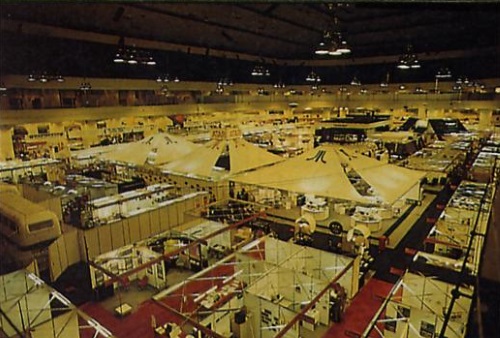
Press room with a view

One of London’s biggest exhibition halls plays host to the hardware makers, software producers, media and locust-like hordes. Lloyd Mangram reports... (Yes, he was there... somewhere...)
What was like it? Was it a tremendous success or a massive flop? Having moved from Olympia to the much bigger Earls Court centre, something about the show had to be massive, didn’t it? Well on Friday, the 14th, the first day open to the public, it looked rather like a massive flop. The huge stands, arranged in a maze Magnetic Scrolls could’ve been proud of, were for the most part rather empty. What visitors there were wandered rather aimlessly through the leisure side, dwarfed by the brash stands erected for them. Things picked up towards the end of the day, but perhaps because of the postal strike (causing difficulties for those who wished to reserve tickets in advance) and it being a school day, attendance seemed low (although the Show organisers, Montbuild, insisted that it was yet another record-breaking attendance — which I find very hard to believe). But if it was all going to be all quiet on the PC Front over the weekend I, for one, would’ve been relieved — after trekking all around the Show on Friday my feet were raw.

Press room with a view
On Saturday the floodgates opened and Earls Court was swamped. Journeys to see the ever-friendly software people (now, understandably due to the poor organisation of stand facilities and equipment, getting rather ratty) required strategic planning to avoid crammed thoroughfares. The queue for the MicroProse Super X simulator seemed to snake everywhere, with signs along its entire route encouraging people to jump the queue by buying MicroProse software from Evesham Micro. When I (eventually) got inside the Super X Prokon sim I was a little disappointed. After all the hype the quality of the picture seemed a little blurry, like a mediocre quality TV picture, but blown-up. The video technology was used to merge together a space shuttle launch (strangely from an external view), and first perspective views of a Tron-like computer graphics trip, taking part in a motorcycle race and a car rally among others. The latter two were among the most impressive and what worked really well was the feeling of acceleration. Logically, you could figure out that this feeling was produced by the simulator tilting backwards, but when the motorcycle lurched across the start line you almost felt you were there.
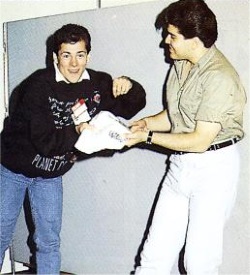
The Editor finds a certain well-known programmer (not dissimilar to Raf Cecco) running off with another CRASH T-shirt
Another American-orientated stand was The Big Apple’s, this cardboard Manhattan trembled to the sound of American rock, while pretty young women handed out promotional leaflets. Prior to the Show the company had promised women dressed as raisins to promote one of the most esoteric (LMLWD) licences ever — a game based on an American raisin ad (very suitable for a UK market, I thought). On my tour around the stand the girls didn’t look that wrinkle-skinned, but perhaps my eyesight isn’t what it once was...
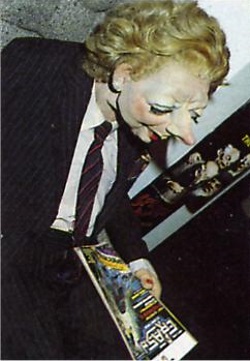
Everyone was reading CRASH down at the Show!
Yet another shining example of Anglo-American relations was provided by Domark’s stand which included a life-size, mechanical Spitting Image puppet of Mrs Thatcher, along with a double-decker bus driven by a latex Rambo! This weird setting was the scene of much celebration as Domark signed a deal with Atari Games, the American coin-op makers now unconnected with Atari computers. To avoid confusion with the latter, Atari Games home computer conversions are labelled Tengen. Part of the deal will involve publicising the Tengen name for people, like me, who hadn’t noticed the tiny Tengen credit on the back of another Atari Games coin-op conversion, The Empire Strikes Back.
Domark’s deal with Atari Games is for the unusually long period of three years and is expected to include around twenty titles. Included among these will be Toobin’ (the coin-op was reviewed last issue) and Vindicators, a battle of futuristic, customised tanks — a sort of cross between Battlezone and Xybots. These should be available sometime next year.
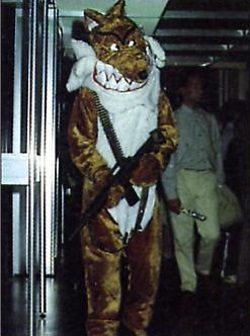
Smile! You’re on Cameron’s camera
Such amicable feelings were notably absent from the Mirrorsoft stand, where a life-size fox was seen strutting around toting nothing less than an M-16 machine gun! If RoboCop had been able to make an arrest no doubt the violent vermin would have protested centuries of relentless hounding as just cause. And, of course, the media were there to glorify the violence. Indeed Mirrorsoft had already got a game called Foxx Fights Back ready for release. Mirrorsoft PR spokesperson Cathy Campos offered nothing in her defence except a review copy, which we, of course, refused on principle. (See page 91 — Ed.)
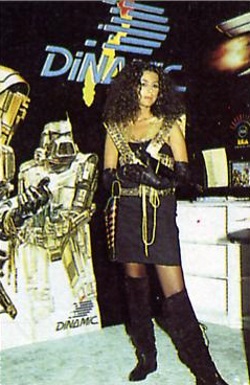
Dinamic!
And of course where there’s violence, albeit of slightly tongue-in-cheek type, no doubt there’s sex too. In the case of the PC Show this was provided not by Corinne Vixen Russell, but by some mini-skirted US Gold girls (arh, they were so sweet — Ed) and — inevitably — the Dinamic stand. Regular readers will no doubt remember the furore surrounding Dinamic’s original Game Over almost exactly a year ago (Issues 43 and 44). The notorious advert featured a certain scantily-clad lady whose virtue, or something, was protected by Oli and his airbrush. (Who could ever accuse Oli of corrupting young minds?)
The appearance of the sequel at this year’s PC Show meant that again Dinamic posters were the show’s most sought after (although Anco’s Strip Poker II posters seemed fairly popular). This year they were bigger, and promoted by a young lady in a modest black dress and Flash Gordon-style golden shoulder pads. Suitably intimidated visitors respectfully asked for posters, while elsewhere their behaviour was more like a horde of locusts, grabbing leaflets, posters and CRASH bags in a ravenous blur.

Just in case anyone said anything horrid about his new baby, Ocean’s Gary Bracey parked the family car on the stand!
Naturally the biggest stands suffered most, and one of the most impressive of these was once again Ocean’s. Nevertheless they seemed to have taken security a little too far — with RoboCop and an armoured car on the stand. Gary Bracey (Software Manager) rather feebly protested that these were, in fact, promotional gimmicks, slapping an Operation Wolf sticker on the armoured car — the locusts seemed little deterred. Gary couldn’t be depressed, however, since his wife had just had a baby boy whom everyone congratulated him on. To celebrate, Gary intended taking the following week off, but Ocean’s programmers are unlikely to get any such rest with many of the stand’s free-play arcade machines set for imminent conversion. One of the most popular of these was Data East’s RoboCop. The computer version still unfinished, it showed the section on this month’s cover mount and was particularly impressive for the characterization and animation brilliantly replicated on the Spectrum. Also looking somewhat unfinished was Ocean’s RoboCop stand-in, with an odd piece of string protruding from his armour. RoboCop spent some time arresting and shooting the visitor-locusts, but soon had to retire due to severe over-heating problems. Disappointed film buffs could console themselves with clips from Rambo II and the fabulous The Untouchables, more Ocean licences. (In fact the Editor was seen spending almost two hours trying to watch each of the films over the heads of bobbing ‘I’ve taken a wrong turn here somewhere?’ business men.)
Another stand loaded with free-play arcade machines was Rebel’s. The label had only just been launched at the show and conversions of their licences are not due till ‘sometime’ next year. How they plan to convert the spectacular 3-D race game Continental Circus to home micros they weren’t saying, but the bandanna things they were handing out proved very popular among those who could tear themselves away from the arcade machines. I had a cursory look around and found the games very impressive, but during public hours the visitors made it impossible to play them, while after hours a horde of reviewers acted similarly...
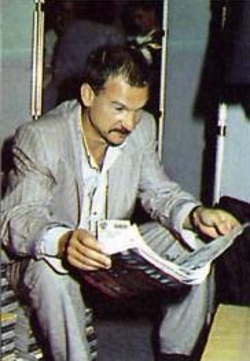
Newsfield’s Mel Croucher looking decidedly normal!
One area I made sure to stay away from was the huge Newsfield stand. Our biggest yet, it was complete with the Computer Art Exhibition and a lounging area at the front. The centre of the action, however, was the sales stand where Directors, Editors and reviewers struggled alongside admin people to serve the maddening hordes. Since only the latter had a clue how to operate the hi-tech till, things were hectic to say the least. But by Sunday, CRASH, ZZAP!64 and THE GAMES MACHINE had all sold out and we were reduced to making humble apologies.

Superman meets THE GAMES MACHINE’s Mercy Dash
One person who apparently had no rest was Nick Roberts who was signing almost as much stuff as Oli — whose posters were selling like nobody’s business. When Nick was absent for the occasional, much-needed lunch break other CRASH staff were often reduced to signing autographs with ‘friend of Nick Roberts’ in brackets underneath. At least all the adulation helped him recover from his encounter with TGM’s Mercy Dash. This Mel Croucher/Robert Evans cartoon character, made real for the show by Helen Rothschild, was equipped with a fairly resilient plastic bottle. This she used to bash all and sundry over the head with. Still, Mercy has her soft side too, and it was she who started the liberal handing out of Olibugs to anyone who asked. From then on everyone was asking for them, from toddlers to people older than even me. (Please can I have one for the wife of my aunty’s brother’s sister-in-law? She’s in hospital, you know. And she reads CRASH every month! ... And perhaps one for her youngest son?) By the end of the Show there were enough empty bug bottles to make Mel Croucher wonder if Mercy hadn’t been on the sauce again.

Even GO!’s Dave Baxter could raise a smile at the PC Show
At least half of the bugs, I was informed, were used by the ZZAP!64 people as a kind of weird self-ornamentation. One Scouse reviewer virtually disappeared under a mass of the fantastic furry fluff balls. Trying to keep a more sober appearance was Mark Caswell. He watched over the fast disappearing CRASH back issues while wishing Jon Bates’s soundtrack for the Art Exhibition sounded more like James Brown. His white shirt alone seemed immune to the latest outbreak of Sticker Wars, with Oli in particularly adept at slapping Newsfield ‘Game Grabber’ stickers over any, lesser, magazines’ wimpy little efforts.
Trying to keep aloof from such activity was Dominic Handy, who sat at the front of the stand with one of the Show’s most satisfied grins as he sold copies of the latest CRASH, occasionally assuring excited customers that this was the best magazine they could buy. ZZAP!64 and TGM staff muttered in disagreement now and then. In general the new stand, like the Show itself, was rated a great success — even if no-one has a clue how to top this stand next year. As for me, well I preferred the cool surroundings of the Press Rooms, a drink and a bowl of cold water for my aching feet.

MicroProse’s ‘Wild Bill’ Stealy (left) and Stuart Bell smile as the crowds gleefully await a little go on the simulator
What I couldn’t miss attending, however, was the final of National Computer Championships. The competition as a whole was organised by Newsfield in association with The National Association Of Boys’ Clubs. Sponsorship was provided by the ever-generous US Gold, on behalf of the Personal Computer Show. (Right, credits out of the way and on with the reporting...) The attempt to find the country’s top games player began in April, with the first regional heats held on May 14. The competition took in such exotic locations as Birmingham, Edinburgh, Leeds and even a platform of Waterloo Station. At each place there were in fact two competitions, one for Spectrum owners and one for Commodore 64/128 bods. The various stages of this ambitious competition were naturally reported in CRASH, with the semi-finals in August ultimately producing the finalists.
On the Spectrum they were ... Stuart Campbell from West Lothian; Paul Roberts from Sheffield; Paul Burridge from Wheatley in Oxon; Michael Deer from Swansea; Steven Smithwhite from West Lothian and finally Mark Sivill from Newent in Gloucestershire. And on the Commodore... Mark Young from Fife; Michael Bonham from Nuneaton; Glen Pickersgill from Hull; Neil White from Edinburgh; Jeffrey Lane from Herts and last, but by no means least, Stuart Witts from Swindon. The finals were held over the three public days of the show, September 16,17 and 18.
The US Gold game provided for the final (on both the Spectrum and Commodore formats) was Roadblasters (84%, Issue 55), a fast and furious racing and blasting game that requires a steady nerve and a very itchy trigger finger. The contestants were asked to play four ten-minute games each (over the course of three days), with the final scores being a total of these four games. Of course this being the PC Show the hall was packed, but some ingenious mind in the Pepsi-Cola camp came up with the brilliant idea of covering a wall with huge video screens (something like the type found at pop concerts). It really only needed a TV company present to record the event for posterity, and enough said, LWT were pressed into service. And so the contest began.
It was a hard fought battle, all of the combatants were determined to win, but at the end of the day there could only be one winner on each computer. The Spectrum winner turned out to be a very capable Stuart Campbell, and on the Commodore ... 14-year-old Mark Young. They both received £1000 worth of software/hardware for their trouble. (Can’t be a bad thing, I thought. I must dust off my old Spectrum one of these days, I’ll be entering next year for sure!)
Before they could think of spending any of it, however, an invitation was extended by Pepsi for the Spectrum and Commodore winners to have a brief, play-off ‘final’. To ensure impartiality it was held on Atari STs, with the then-unseen Mad Mix Game — the first Pepsi Challenge computer game (the Spectrum version is reviewed on page 86.) It was a tough battle, but Mark narrowly pipped Stuart to the post, 28000 points to 20000. Both players won various Pepsi-Cola goodies, and Mark Young left with the title of 1988 Pepsi Challenge Champion. Congratulations to both winners.

Now that’s what I call a haircut! The way ahead for Spectrum champions?